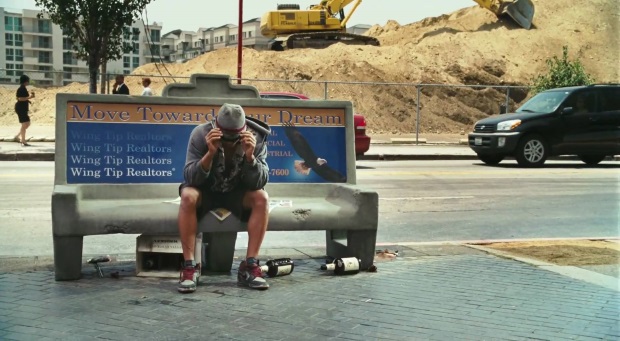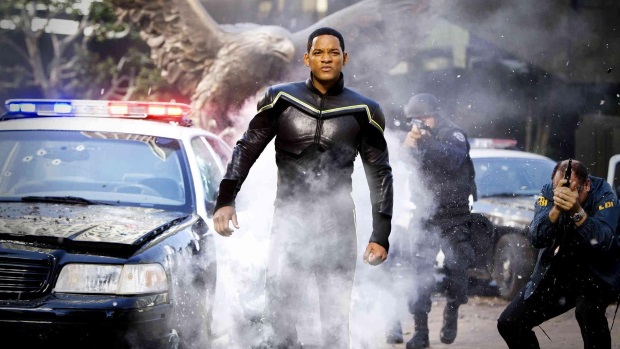The Troubled Development of Hancock
Hancock, the Will Smith superhero movie, didn't have an easy production.
This article comes from Den of Geek UK.
This feature contains spoilers for Hancock.
Back in the 1990s, Will Smith ascended from being the Fresh Prince to being the king of the Fourth of July weekend. Summer blockbusters like Independence Day and Men in Black cemented his position as a box office draw well into the following decade. Naturally, Smith has pursued other avenues as his career has gone on, but arguably 2008’s Hancock was the last full-on star vehicle he opened on that coveted weekend.
Developed from a widely hyped spec script titled Tonight, He Comes, the film cast Smith as a stumblebum superhero known as John Hancock, who is widely disliked by the citizens of Los Angeles. Booze-addled and depressed, Hancock finally resolves to turn his life around with the help of PR consultant Ray (Jason Bateman) but things go off the rails when he grows closer to Ray’s wife Mary (Charlize Theron).
The movie was a big hit at the time–not only did it give Smith his biggest opening weekend at the U.S. box office at that point in his career, but it also wound up being the year’s fourth highest-grossing movie worldwide. But that financial success was tempered by lukewarm reviews on account of the film’s lurching tone and messy editing.
The theatrical cut of the film runs at a cool 88 minutes and has some fairly wild inconsistencies to swallow. Although the 97-minute extended cut was praised for reinstating deleted scenes that ironed out some of the tonal wrinkles, the movie still feels exactly like the product of its troubled development. Looking back at how Tonight, He Comes morphed into Hancock over a period of 12 years, it’s entirely unsurprising that the film wound up the way that it did. It’s a movie that arrived later than expected, and yet much too early to work as intended.

Tonight, He Comes
As those of you who have watched the theatrical cut might suspect, the original title of the project hinges on an infamous line of thought that was covered in Larry Niven’s 1969 essay “Man of Steel, Woman of Kleenex” and out loud in Kevin Smith’s Mallrats. If you’re unfamiliar with either of those, it basically asks how someone like Superman, with his physical capabilities as a Kryptonian on Earth, could ever safely consummate his love for a relatively fragile Lois Lane.
In the original 1996 draft of the script by Vy Vincent Ngo, Hancock is more like a real superhero and thus jaded by his lonely existence. While the story still sees him connect with a regular family, it’s more about his awkward relationship with the 12-year-old son and his inappropriate obsession with the mother than his buddying-up with the milquetoast dad.
Clearly aiming for an R-rating, the 226-page script is ambitious but also overlong and pretty grim. When sent the original script, executives at Warner Bros. reportedly responded to Akiva Goldsman, a producer who’d become attached to the project, by saying “No. No. No, no, no.” During later development, there was definitely a middle-ground between that conception and the lightweight summer blockbuster fodder we got.
The script generated some initial buzz when Goldsman became attached and was able to gather some potential interest from directors Tony Scott and Michael Mann. Mann has a producer’s credit on Hancock, but given the chance to direct it, he ultimately opted to make 2006’s Miami Vice instead. After Mann passed, Jonathan Mostow (Terminator 3: Rise of the Machines) became attached and ordered a new treatment of the film to be packaged for Smith.
One of the writers behind this was John August (Big Fish), but the other was Breaking Bad‘s Vince Gilligan, who would go onto write several drafts of the film and share a co-writing credit with Ngo. Gilligan introduced a lot of the stuff we see in the finished film–specifically the mad backstory that reveals Mary and Hancock to be the last two members of an ancient race of immortal beings. He also, crucially, kept the R-rated and character-driven approach.

Big Willie Style
When Smith became attached, Tonight, He Comes became a hot property. Columbia Pictures acquired the project in 2005, with Smith getting a pay-or-play deal. The film was set to shoot in summer 2006 with The Pursuit of Happyness director Gabriele Muccino in the frame to direct. However, Muccino was still finishing that film at the time and Smith was waylaid by another pay-or-play deal on another Goldsman film, I Am Legend, so the film was pushed back a year.
Muccino walked away in the course of that year, like Mostow before him, over creative differences with the studio. Therein lies the rub–even though everyone who was attracted to this project was in it for the R-rated superhero deconstruction, there’s no doubt that Sony was looking for a big summer blockbuster. And back in 2008 that meant a PG-13 rating.
After Sony picked up the film, it’s not difficult to see how creative differences arose. By the time director Peter Berg boarded the project, there were plenty of questions about whether or not a superhero should be seen swearing in front of children, flying under the influence, or sleeping with his friend’s wife, especially when that superhero was played by Will Smith.
Right as production was about to begin in earnest, Gilligan went off to make Breaking Bad. Any Hollywood movie of this size will amass a number of uncredited rewrites, but tonally, the difference between Gilligan’s draft (which is available online if you look for it) and the film is like night and day. In part that’s due to the casting of Smith. By no fault of his own, his screen presence has thwarted his obvious ambition to pursue meatier acting roles throughout his filmography. In this case, when test audiences saw the movie, they hated seeing Smith play a depressed and stand-offish lead, which also factored into the continual downscaling of the film to be suitable for PG-13 audiences.
But in the main, Sony had clearly decided that they wanted a Will Smith summer blockbuster rather than a dark comedy with an anti-hero. Aside from changing the title from Tonight, He Comes to the more generic John Hancock, and then just Hancock, the studio submitted the theatrical cut to the MPAA three times. After the first two attempts received an R rating, they continued to tone stuff down by editing or excising beats.
As a result, a lot of context for Hancock’s behavior is stripped out, so it doesn’t help that his Marty McFly-styled “chicken” button is just him overreacting to being called an asshole. It’s tougher to empathize with him because when the film doesn’t want to grapple with more grown-up issues, he just comes across as an asshole, albeit a very PG-13 one.
“Reach the Top”
A deleted scene from Gilligan’s script illuminates why Hancock feels so much like a missed opportunity. After the city-smashing chaos of his heroics in the opening sequence, Hancock goes to a bar, gets chatting to a young woman, and takes her back to his trailer.
Before they get it on, he warns her that she needs to get away from him before he “reaches the top,” which the filmmakers presumably hoped would be a tame enough way of putting what’s about to happen. The punchline comes when he pushes her away and blows three holes in the roof. So, the whole “Man of Steel, Woman of Kleenex” set-piece was shot but ultimately cut out of the film.
“It just wasn’t that funny,” Berg explained, “Never was. You’d put it in front of an audience and there’d be two, maybe three people laughing. There was no way to do that and then regain even a modicum of emotional integrity.”
That’s fair enough, compared to a film that was evidently significantly altered by test audience reactions. But by losing that scene, you lose a vital character moment that follows it. The woman looks freaked out and claims she’s going to the bathroom while a bashful Hancock suggests nice things they could do together instead, like go for a flight above the city. But she’s already snuck out the window and fled in terror with Hancock watching sadly as she drives away.
read more: I Am Legend – Why Can’t the Book Be Done Justice
There’s no real substitute for that character-building moment in the film proper and it feels like a vital component is missing. The underlying sadness that survives in some of the early scenes is just a remnant from previous versions of the movie. It’s like a scar left over from the process of turning it into a big comedy where the hero jams a man’s head up another man’s bottom.
In the end, the difference is massive. By the end of Gilligan’s script, Hancock comes to terms with his depression by choosing to embrace his powers and finding some fulfilment in being a hero. By the end of the film, a plot contrivance forces him to move from LA to New York, and “One Month Later” he seems cool with that. It rings false and ultimately sells the premise short.

Premature Release
Eddie Marsan once told Mark Kermode and Simon Mayo that his worst performance was in Hancock. Marsan plays bank robber Red, a role that was greatly diminished from its counterpart in Gilligan’s script. At the end of the interview, he mentioned that he was in Deadpool 2, which serves as a funny reminder of the difference between an R-rating now and an R-rating in the 2000s.
For as long as Hancock took to get to big screens, it still feels like the film missed its moment by arriving 10 years too early. Post-Deadpool, an R-rated anti-hero comedy is a much more lucrative prospect than it once was. While Smith’s own screen presence worked against the movie back then, it needn’t have been so if the script had stayed on the shelf for a few more years.
Besides back in 2008, the state of comic book movies did this deconstructive treatment no favors whatsoever. Hancock‘s release on the Fourth of July weekend planted it in between Iron Man (with a Robert Downey Jr. performance that Berg optimistically compared with the tortured portrayal of a superhero that he and Smith were attempting) and The Dark Knight in the summer blockbuster season.
While it didn’t hurt its box office, it’s a film that feels far more dated than either of those as a result of when it was made. At the time, it was touted as a gamble by insiders who were familiar with the project’s origins, but from the post-production to the marketing, the finished product became rather more toothless than it should have been.
Still, the movie isn’t all bad. Aside from reuniting the strong partnership of Bateman and Theron (MISTER F…), there are a few funny gags in the first half, but the mid-point reveal of Mary’s true nature is a real narrative stumbling block in a film that was so consistently rejigged, and the second half never really recovers. It feels like a case of death by a thousand cuts, but then most studios wouldn’t have as many qualms banking on an R-rated superhero comedy nowadays.
Incidentally, the record for Smith’s biggest opening weekend has since been overtaken by Suicide Squad, another poorly received PG-13 film in which he plays an anti-hero. You wouldn’t have bet on the world’s biggest movie star playing a second-string Batman villain back in 2008, but in hindsight, Hancock came at something of a turning point between the blockbuster vehicles on which he made his name and the end of the era in which stars, rather than brands or characters, could open a movie.